9 Sexuality
Module Learning Objectives (MLO)
In this chapter, you will
- MLO 9.1 Identify foundational concepts related to sexuality, fashion, identity, appearance, and dress. [CLO 1]
- MLO 9.2 Identify different types of dress worn by queer communities in the United States to express their sexual identities. [CLO 1]
- MLO 9.3 Identify queer people’s experiences in the United States wearing different dress object reflecting their queer identities. [CLO 2]
- MLO 9.4 Identify different fashion brands that produce and sell dress objects for the queer community in the United States to affirm their sexual identities. [CLO 1]
- MLO 9.5 Explain the role of dress and appearance in the development of one’s queer identity in the United States. [CLO 1]
- MLO 9.6 Examine how dress and appearance of queer communities in the United States are represented in the fashion system (e.g., by advertisements or retailers). [CLO 3]
- MLO 9.7 Examine social justice issues related to dress and appearance of the queer community in the United States. [CLO 3]
- MLO 9.8 Deconstruct your own perspectives and approach to understanding the dress and appearance of the queer community in the United States. [CLO 4]
- MLO 9.9 Identify the driving forces of transformative social justice change in the fashion system related to queer identities in the United States. [CLO 5]
In this chapter, we explore the scholarship examining the intersections of the queer community, identity negotiations, and dress. However, doing so is tricky because significant nuance lies in identity, and the scholarship is not necessarily provided in clear categories, given identity’s fluidity and complexity. Therefore, while the work is presented under the stable headings outlined below, when tensions arise in the literature, they are noted. The plethora of work on these topics dissolves the idea that there is one monolithic aesthetic or style for different queer identities.
The Center for Educational Justice & Community Engagement’s Definition of Terms is a great resource to help you understand some of the concepts that intersect with lesbian, gay, bisexual, queer, and other sexual minorities.
Gender Identity
Although the two concepts interact in many ways, gender identity is distinct from sexual orientation. Just like not all cisgender people are straight, not all transgender people are gay or lesbian.
I either, I would say queer or bisexual depending on who asks. I like queer better, I like the vagueness and implications but bisexual is a word people know. I’m attracted to people of all genders.
Heterosexuality is the romantic attraction, sexual attraction, or sexual behavior between persons of the opposite sex or gender. Even though transgender people identify with the queer community, they can still be heterosexual. For example, a transgender woman and a cisgender male in a relationship are a heterosexual couple.
There are many ways to identify in the queer community, and individuals often use various terms or switch among them.
Queer sexual spectrum
On the queer spectrum, these questions may not align with a singular sexual identity:
- Sexual identity: “Who am I?”
- Sexual orientation: “How am I attracted?”
- Sexual behavior: “How do I engage sexually?”
Sexuality and Signifiers
Many overt symbols of sexuality are used in the LGBTQIA+ community. Often, sexuality can overtly influence appearance or dress, though this is not always the case. For all individuals in the queer community, a common theme throughout history has been the “pushing of gender boundaries.” The signs and symbols of sexuality for queer individuals change and shift over time.
Gaining Momentum: Stonewall
The Stonewall Riots, in 1969, marked a period of great movement toward equality for the LGBTQIA+ community. Read what the Stonewall Riots were here: “History of the Stonewall Riots” (History.com editors, 2021).
Following these riots and the formation of numerous groups such as the Gay Liberation Front, slogan badges and T-shirts became an important signifier of support or pride. Today, these items continue to act as signifiers of belonging in the queer community.
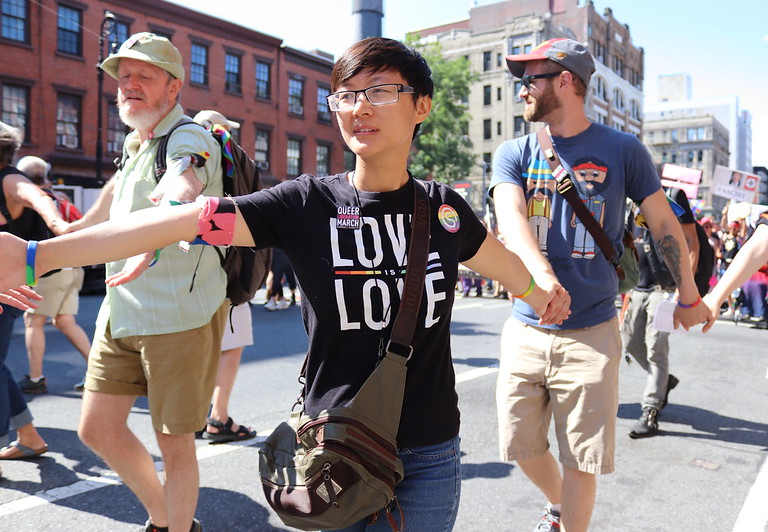
Nazi-Occupied Germany
Overt signifiers of LGBTQIA+ identities have sometimes been forced on members of the community. Gay men in Nazi concentration camps were forced to wear uniforms bearing pink triangles as designations of homosexuality. Similarly, women who did not conform to social roles, often believed to be lesbians, had to wear black triangles.
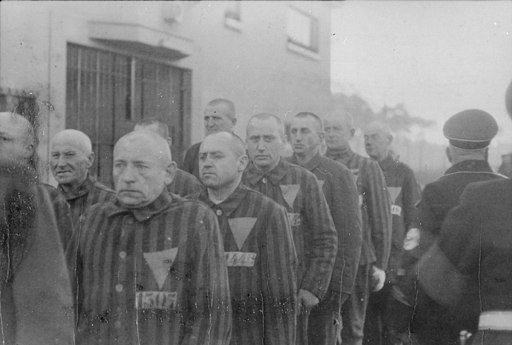
Today, triangles are sometimes incorporated into clothing and accessories as symbols of freedom rather than symbols of oppression. This is an example of reclamation, wherein a member of a community who is harmed by a term, phrase, or symbol might choose to use that signifier in a positive way to challenge the stereotypes surrounding it.

Review the Stigma and Identity section in chapter 2 for more information about how members of a stigmatized community can reclaim or refute negative stereotypes.
Distinctions between Drag and Cross-Dressing
Within discussions about the LGBTQIA+ community, newcomers often conflate the terms drag and cross- dressing. However, there are some important differences between the two terms.
Drag
Drag refers to the conscious performance of femininity or masculinity, sometimes in an exaggerated manner, usually in a show or theater setting. When individuals perform femininity, they are referred to as queens, and when they perform masculinity in the same way, they are referred to as kings.
Watch this short film to learn about drag and terms related to it:
Cross-Dressing
In contrast to drag queens and kings, cross-dressers wear clothes, makeup, and other forms of dress that are considered by their culture to be appropriate for a gender not their own. While people generally wear drag for entertainment purposes, they cross-dress for personal reasons. The term cross-dresser falls under the umbrella term transgender, though not all cross-dressers consider themselves trans.
Lesbian Identities and Dress
In a survey of mainstream popular press articles in the United States from 1960s to the 2010s, publications featured mostly White, thin, feminine lesbian aesthetics and styles (Reddy-Best & Jones, 2020). These mainstream representations lacked the nuance, tension (Kaiser, 2012), and variety of styles that lesbian-identifying women have embraced over time. Many of these styles are intricately related to gender negotiations; however, lesbian styles expand beyond the stereotypical notions of butch and femme often perpetuated in media.
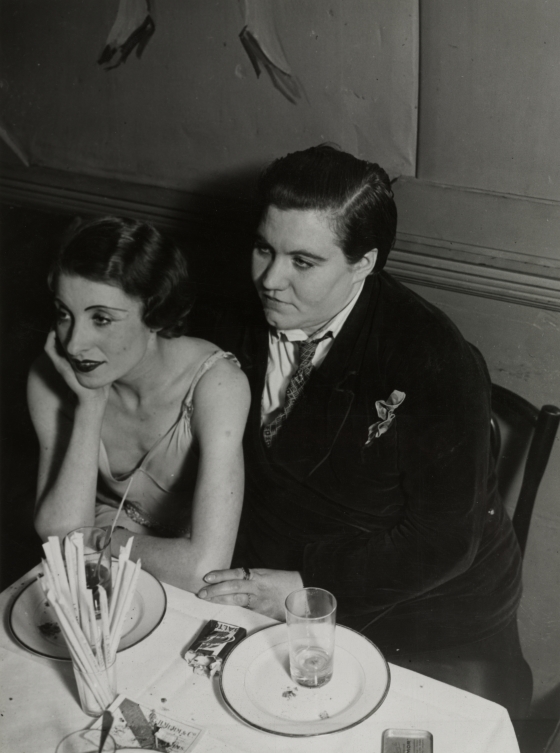
Early documented evidence of women’s styles in same-gender relationships dates to the eighteenth century. Elanor Butler and Sarah Ponsonby, two Anglo-Irish aristocrats who were thought to have been in a love relationship, often adopted masculine styles of clothing; more specifically, they routinely wore riding habits, considered a subversive act because women did not customarily don the outfits they wore for riding at that time (Wilson, 2013). Anne Lister, a wealthy White woman from Yorkshire who died in the late nineteenth century, wrote in her diaries of her desires and relationships with other “mannish women,” and she also embraced an eccentric, masculine style (Wilson, 2013, p. 171).
In the 1928 novel The Well of Loneliness, author Radclyffe Hall crafted a lesbian identity in a masculine aesthetic (Geczy & Karaminas, 2013). In the same decade, photographs Albert Harlingue took of women at Le Monocle, a lesbian club in Paris, depicted White-appearing women in the popular garçonne look, a fashionable women’s style in larger society (Farrell-Beck & Parsons, 2007), “characterized by an absence of feminine curves and very short hairstyles” (Steele, 2013, pp. 26–27). Harlingue’s images also featured women in highly feminine styles and wearing bias-cut dresses with form-fitting silhouettes, longer hair, and makeup. Georges Brassai also took similar photographs. Faderman (1991) discussed lesbian dress aesthetics in the early part of the 20th century and explored these recognizable masculine and feminine norms, frequently referred to as butch and femme, which she argued emerged in 1940s bar culture, where butch and femme lesbians congregated. Leslie Feinberg’s popular 1993 novel Stone Butch Blues gave vivid descriptors of the mid-20th-century butches and femmes. For example, Jess, the main character, related their experience when first entering a bar in Niagara Falls: “What I saw there released tears I’d held back for years: strong, burly women wearing ties and suit coats. Their hair was slicked back. They were the handsomest women I’d ever seen. Some of them were wrapped in slow motion dances with women in tight dresses and high heels who touched them tenderly. Just watching made me ache with need” (p. 28).
Rothblum (1994) argued that lesbian communities have adopted styles and aesthetics that differ from those of mainstream society. One of the ways this has manifested is through embracing and negotiating a masculine aesthetic, sometimes referred to as butch. The butch, masculine-lesbian style is often recognizable within as well as outside of the lesbian community (Maltry & Tucker, 2002; Taylor, 2007). A butch aesthetic may include comfortable shoes, little or no makeup, tattoos and piercings, alternative-style haircuts or hair colors, and masculine-leaning garments or accessories (Clarke & Spence, 2013; Clarke & Turner, 2007; Esterberg, 1996; Reddy-Best & Pedersen, 2014, 2015; Rothblum, 1994, 2010). While different lesbian styles, including those that are part of the butch aesthetic, are often considered uniform, women adopt masculine styles in complex and varied ways (Levitt & Hiestand, 2004; McLean, 2008). For example, in Reddy-Best and Goodin’s (2020) research, participant Cyndi—a White, lesbian-identifying woman—claimed her overall style was masculine-leaning but said she felt like a “delicate flower on the inside” and preferred the phrase “soft butch” (125).
In her 2019 work, Blake analyzed Black androgynous lesbians from North Carolina. Blake explained, “[I am] hesitant to essentialize Black lesbian styles of dress . . . instead of naming these gender presentations Black lesbian style, I call these articulations of Black lesbian androgyny BlaQueer Style because they represent—rather than essentialize—the racial and class politics illuminated by their dress” (p. 11).
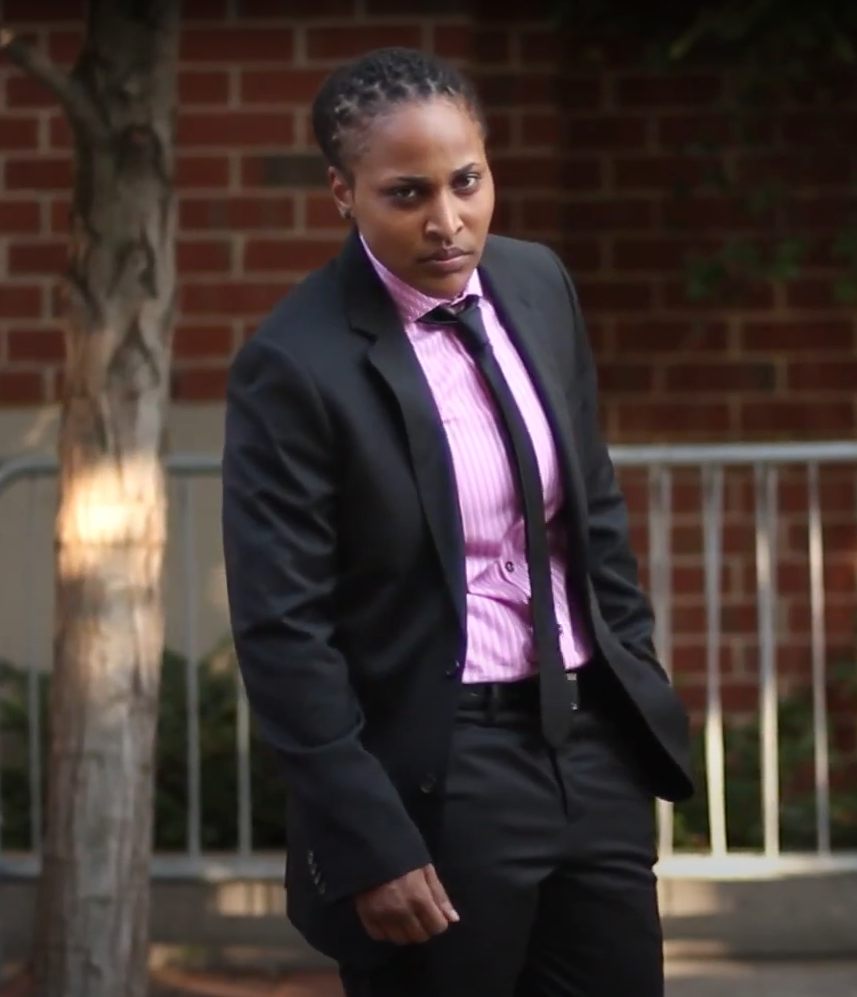
Blake (2019) outlined the ways these women embraced masculinity and the tensions surrounding their multiple subjectivities, with emphasis on their Black identity. Lane-Steele’s (2011) work examined studs, or Black lesbians who embrace masculinity; the studs she interviewed said they dressed similarly to their Black male peers, with “baggy pants and shirts, hats, high top shoes, Timberland boots, and fairly flashy jewelry” (p. 484). Lane-Steele drew connections between these women’s styles and “protest masculinity” (p. 483), which Connell and Messerschmidt (2009) defined as“[the] pattern of masculinity constructed in local working-class settings, sometimes among ethnically marginalized men, which embodies the claim to power typical of regional hegemonic masculinities in Western countries, but which lacks the economic resources and institutional authority that underpins the regional and global patterns” (p. 848). One way protest masculinity surfaces is through a hyper-masculine aesthetic—such as the one these Black lesbian women embraced.
In addition, much research has analyzed feminine-leaning aesthetics, sometimes referred to as femme, high-femme, or lipstick lesbian styles or identities. Feminine-leaning lesbians may wear long hair, makeup, and feminine-coded clothing, such as dresses or high heels (Hemmings, 1999; Levitt et al., 2003; Levitt & Hiestand, 2004; Levitt & Horne, 2002; Maltry & Tucker, 2002). Because of the long-standing association between femininity and heterosexuality, feminine-leaning lesbians are often misread as straight (Huxley et al., 2014; Levitt et al., 2003) and can experience accusations of not being “queer enough” within the LGBTQIA+ community (Reddy-Best & Goodin, 2020). They may hide their lesbian identities until they are physically with their masculine-leaning partners (Rossiter, 2016).
Watch this short film on femme identity and dress.
To view a transcript for the video above, download this file: The Femme Struggle Transcript [DOC]
While many folks adopt and embrace these stereotypical aesthetics that are thought to have developed out of the mid-20th century, there have been significant critiques and rejections of these styles altogether. As social movements gained traction in the latter part of the 20th century, some criticized these feminine- and masculine-leaning aesthetics for producing a heteronormative performance (Walker, 1993). In Freitas et al.’s 1996 study, participants related that they did not want to limit themselves to one particular type of style. Additionally, Hammidi and Kaiser (1999) theorized there was no single way to imagine beauty for lesbian women, and these negotiations are intertwined with ambivalence and tensions in everyday life. This notion is evident in a recent New York Times article titled “Lesbians Invented Hipsters,” in which Burton (2016) asserted, “You’re all lesbians now, America. . . . I’m sorry. But mostly for myself. Because it’s hard to tell who’s queer now.”
Watch this short film on the experiences with clothing and dress of queer women who live in the Midwest.
Watch this short research presentation about queer women’s identity and dress.
Gay Identities and Dress
Because of the stigmatization and criminalization of homosexual behavior in much of European–American modern history, gay men have frequently adopted coded styles to display their gay identity. These symbols have included adorning one’s lapel with green carnations and wearing red neckties or suede shoes.
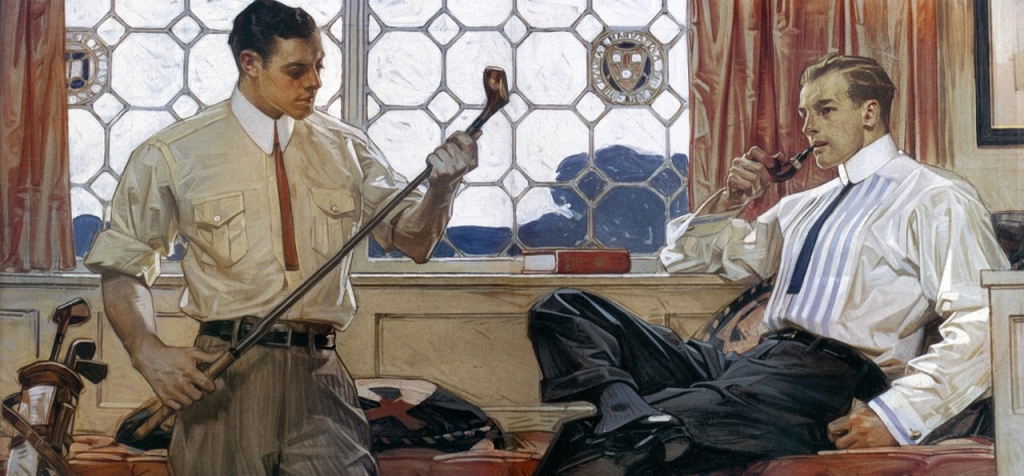
As legal progress has been made and the social climate for the LGBTQIA+ community has improved, the symbols shifted from knowledge among the few to commonplace, as in dress that now includes rainbow flags, the inverted pink triangle, or an earring worn in the right ear (Cole, 2000; Reilly, 2010).
During the early modern gay liberation movement, gay men were mostly divided into two ideologies regarding how to present themselves through dress: embrace traditional masculine gender presentation or subvert it (Edwards, 1994). Cole (2013) noted that the Gay Liberation Front of the 1970s employed “genderfuck” aesthetics, combining stereotypical masculine and feminine clothes, makeup, and styling into one form to subvert Western binary gender expectations in Great Britain and the United States to combat, question, and highlight gender’s artificial nature. These two philosophies and tensions—to embrace traditional Western gender presentation or to disrupt it—continue in contemporary post-postmodern forms of androgyny (Barry & Reilly, 2020).
The conflict over how to present one’s self resulted in the “butch shift,” in which gay men developed dress styles based on masculine archetypes (Humphries, 1985), such as leather men, bears, and Castro clones. Bears, noted for their hirsute, either muscular or husky/large/fat and blue-collar representations of masculinity, became visible in the 1980s during the early AIDS crisis and were eroticized for their perceived health as compared to the emaciated appearances of those suffering in the latter stages of AIDS. Mosher et al. (2006) argued that leather identity is socially constructed and performative and both “bear and leather aesthetics can be understood as expressions of culturally valued traits and as a reconciliation of masculine and gay identities” (pp. 119–120).

Cole (2000) noted the Castro clones style emerged from American cowboy and blue-collar dress (e.g., jeans, plaid shirts, cowboy boots, construction boots, Levi’s 501 button-fly jeans, T-shirts, short hair, and mustaches) and was symbolic of “toughness, virility, aggression, strength, [and] potency” (p. 128), although Levine (1998) argued the look was parody. Although clone aesthetics were patterned after heterosexual masculine styles, a knowing gay consciousness acknowledged the outfits were coordinated, perfected, and worn to show off the male physique. Cole (2000) further argued the clone image of masculinity influenced other gay men’s styles, including “queer nation” and “act-up” looks (e.g., T-shirts and jeans), gay skinhead, and gay rockabilly. The clone style assisted in redefining gay men as masculine. Other gay subcultures that embrace masculine aesthetics include muscle boys, scallies, and homothugs (Cole, 2008).
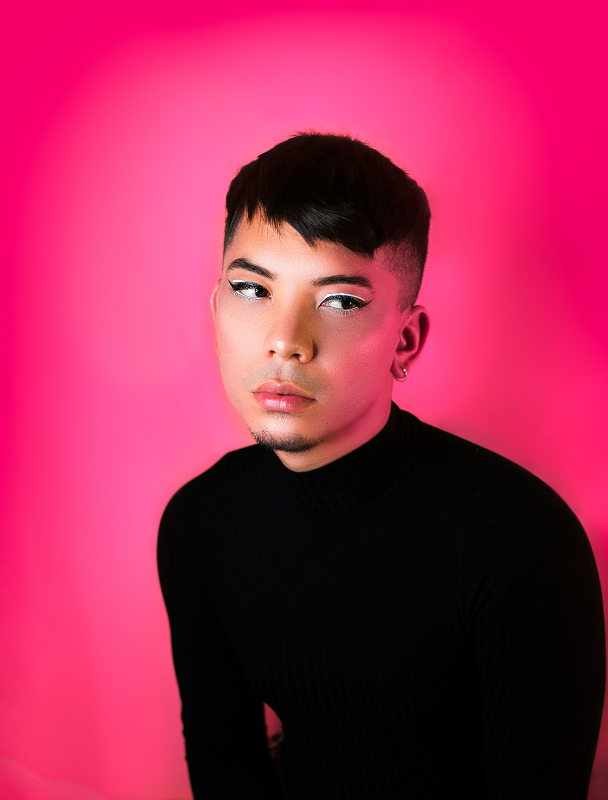
In contrast to masculine archetypes, other gay men, such as drag queens and punks, embraced camp, feminine, or androgynous aesthetics, including makeup and jewelry. Contemporarily, a result of the butch shift has been the tendency among some gay men to embrace femininity (Reilly, in press) and to incorporate apparel items marketed to both men and women into their wardrobes (Barry & Reilly, 2020; moore, 2020). Per Barry and Martin (2015), gay men view contemporary aesthetics as more varied than previous generations, and gender identity, sexual orientation, and race intersect not only to express individuality but also to challenge binary gender norms by mixing traditionally feminine and masculine fabrics, textures, products, and other signifiers (Barry & Martin, 2016). Clarke and Turner (2007) similarly argued that clothing is used to negotiate gay identity, but it is also used to express individuality; thus when an individual “comes out,” they may feel expectations to dress a certain way, but enough room exists in the unwritten rules of gay aesthetics to show one’s persona in a multitude of ways.
Gay men adopted other items, among them sailor uniforms and sneakers. In England and France between the world wars, gay and bisexual men wore the sailor uniform because it was associated with masculinity and voracious sexuality and it had a figure-revealing fit and silhouette. Use of the sailor uniform diminished when it was adapted into mainstream fashion (Stephenson, 2016). Scott (2011) proposed that sneakers were important to gay men in three ways. First, they can be viewed as feminine and are thus discouraged if one wants to appear masculine (e.g., biker and leather subcultures eschew sneakers and favor boots). Second, they can be viewed as masculine among middle-class gay men and as part of the butch shift or as gay men assimilated (e.g., jocks and straight-acting mainstream masculinity). Third, sneakers are considered masculine but fetishized, as in, for example working-class subcultures or gay skinheads.
Much of the research on gay men’s dress has been conducted on White men, leaving significant opportunities for future research on other races and ethnicities. However, the research that has been conducted has yielded important findings. Cole’s (2019) work on gay Black men in Britain and the United States reported that gay Black men find attention to detail important, considering age, race, class, and how one wanted to present oneself with consideration of time and place: “What constitutes gay men’s style and what constitutes Black gay men’s style raises questions about whether it is possible to identify gay styles broadly and Black gay styles specifically at this time” (p. 54). Drummond (2005) argued gay Asian men have different clothing styles for home, straight or mainstream, and gay spheres.
Tan (2019) documented the dissemination of the bear style from the United States to Japan, through Northeast Asia, and into Taiwan and found bears in Taiwan cultivate their look to achieve sexual capital by using clothes—such as tank tops or bright colors on sleeves and torsos of shirts—to draw attention to their thick or beefy bodies. Last, Horton’s (2020) research on the regulation of flamboyant dress, or fabulousness, in India, from within its own gay communities, argued dress has become politicized—a matter of respectability politics rather than one of enjoyment of pushing boundaries.
Bisexual Identities and Dress
Some scholars have focused specifically on the ways bisexual-identifying individuals negotiate their identities through dress. Taub (2003) surveyed mostly White, bisexual-identifying women and reported that these women fashioned their bodies in a variety of ways; in their responses, there was significant discussion of negotiating societal gender norms and stereotypical lesbian appearance norms. Some of these women rejected dominant culture’s norms and created “personalized and affirming beauty ideas and practices,” whereas others felt pressure to conform to lesbian norms, such as the “soft butch” aesthetic (p. 21).
Hartman (2013) conducted interviews with mostly White, bisexual-identifying women. Participants frequently relayed a desire to make themselves visible as bisexual in public settings because of their belief that society often deems them invisible, which is sometimes referred to as bi-erasure (for discussions of bisexual invisibility, see Bradford, 2004; Firestein, 1996; Fox, 1995; Tabatabai & Linders, 2011). Participants used the terms attitude and androgyny and a hybrid of heterosexual and homosexual aesthetics to describe a bisexual display, and they placed significant emphasis on gender negotiations through style. The participants described their uses of overt pride aesthetics, such as pins or slogan T-shirts—particularly those with the bi-pride colors (pink, blue, and purple). Although Hartman’s (2013) participants articulated specific aesthetics to highlight their bisexual identity, they also expressed that it was “difficult to pin down such a description” (p. 49). Similarly, other researchers found a lack of distinct dress aesthetics for bisexual individuals (Clarke & Spence, 2013; Clarke & Turner, 2007; Hayfield, 2011; Hayfield et al., 2013; Holliday, 1999; Huxley et al., 2014).
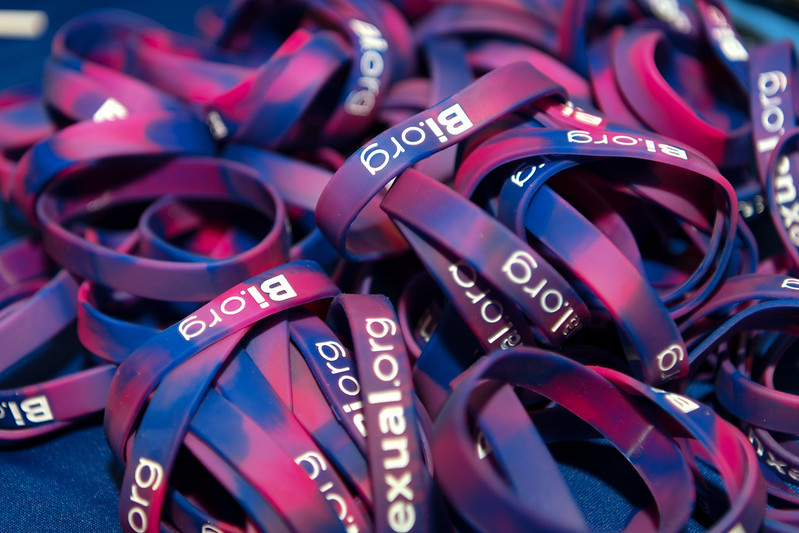
Hartman-Linck (2014) discussed the importance of bisexual signifiers in private or intimate spaces, such as around close friends or family. Her participants also related using aesthetics of the home, such as magnets or artwork with lesbian symbols, to signify their identities. Artwork or magnets are arguably not “hand-held objects” (Roach-Higgins & Eicher, 1992, p. 1), yet they are debatably an extension of the body in the context of these private spheres.
In a recent study, Daly et al. (2018) again examined bisexual women’s appearance and dress. Similar to the aforementioned studies, the bisexual participants’ appearance markers conformed to stereotypical lesbian aesthetics (or masculine-leaning styles), or they adopted mainstream gender norms by using feminine signifiers. The participants’ partners’ genders often motivated adoption of various styles. For example, some women in same-gender relationships adopted feminine aesthetics to avoid having others assume they identified as lesbian.
Duffin (2016) interviewed African American men who were behaviorally bisexual but identified as straight and described themselves as “on the down low” or “DL” (p. 484). The down-low phenomenon is significant in the Black community because of the stigmatization of homosexuality; the phrase, which emerged in rap music lyrics in the 1990s (Cohen, 1999), has been discussed in popular press articles (Denizet-Lewis, 2014). Dress was not the primary focus in Duffin’s (2016) work, but in one part of his results, he reported that men often associated femininity with being gay. That is, these bisexually behaving men asserted their masculinity by wearing baggy or other stereotypically masculine styles. By contrast, one participant defined being gay as wearing “tight clothes, swish[ing] up and down the street, [and] act[ing] like a girl” (p. 499).
Required reading
Huxley, C., Clarke, V. and Halliwell, E. (2014). Resisting and Conforming to the “Lesbian Look”: The Importance of Appearance Norms for Lesbian and Bisexual Women. J. Community Appl. Soc. Psychol., 24: 205-219. https://doi.org/10.1002/casp.2161
Kelly L. Reddy-Best & Elaine L. Pedersen (2015). The relationship of gender expression, sexual identity, distress, appearance, and clothing choices for queer women. International Journal of Fashion Design, Technology and Education, 8:1, 54-65, DOI: 10.1080/17543266.2014.958576
To access these articles, read them on campus or look them up on the University Library website and log in with your NetID and password.
The Fashion Industry and LGBTQIA+ Identities
In the 2010s, there was a significant emergence of queer-focused brands in the fashion industry selling a variety of different products, such as suits and suit coordinates, sportswear, accessories, swimwear, shoes, and undergarments or other objects worn near or against the skin (Reddy-Best et al., 2020; Reddy-Best, 2017, 2020; Reddy-Best & Goodin, 2018). Many of these brands garnered widespread attention in 2016 when HBO released Suited, a documentary about Bindle & Keep—a Brooklyn, New York–based company that produces suits and suit coordinates for gender-nonconforming people. Many of Bindle & Keep’s clients described feeling—for the first time in their lives—comfortable in their suits and liking the way they looked in the mirror (Benjamin, 2016). Because many LGBTQIA+ individuals push gender boundaries in their dress, they often have difficulty shopping for clothes that fit their bodies and desired gender and/or sexual presentations (Pierre, 2020; Reddy-Best & Pedersen, 2015); many of these queer-focused fashion brands emerged to address these issues.
Many of the entrepreneurs who started these businesses cited entering the industry because they were unable to find clothing that fit them or their partners (Benjamin, 2016; Reddy-Best, 2020; Reddy-Best et al., 2020). For example, Thúy of Thúy Custom Clothier asserted they could empathize with their clients and the inability to find masculine-leaning clothes, and this ability to empathize has created a trusting shopping environment (Reddy-Best et al., 2020). Bindle & Keep designer Rae Tutera recalled their first suit: “I just never felt so good about myself before. It was just such a powerful experience for me. I couldn’t help but want to take it and adapt it to a landscape that welcomed people like me” (Benjamin, 2016, 5:14). Some brand owners may not personally have difficulty finding clothing, but a loved one might. For example, Abby Sugar was inspired to start Play Out because her ex-wife was unable to find masculine-style underwear (Reddy-Best et al., 2020).
The development of the Internet and the increase in LGBTQIA+ rights in the United States were catalysts for the creation of some brands. For example, Saint Harridan, now closed, developed alongside the legalization of same-sex marriage and the need for masculine-leaning wedding attire for gender-nonconforming individuals (Reddy-Best, 2020). Additionally, with the changing retail landscape and the increase in e-commerce, designers are no longer required to pitch to wholesale buyers or generate the overhead to build and sustain storefronts (Worsley, 2011). Therefore, these brands can enter the market with little to no capital investment. Social media has also allowed brands to target and attract customers (Reddy-Best et al., 2020). For example, Rebirth Garments—a company that designs garments and accessories that promote queerness, disability, and fat identities—sells products from its Etsy store and accepts orders via direct messages on social media (Reddy-Best & Goodin, 2018). These virtual spaces have also allowed brands to politicize fashion by circulating imagery that challenges larger hegemonic gender norms. For example, Saint Harridan worked with Miki Vargas, a queer-fashion photographer, to capture gender-boundary-pushing aesthetics. As these images circulated on Saint Harridan’s social media, discussions often focused on “gender and identity politics,” “shifting ideologies surrounding gender,” and “signs of solidarity with other groups experiencing oppression,” such as people of color (Reddy-Best, 2020, p. 99).
Unfortunately, several brands have since closed (e.g., Saint Harridan stopped operations only four years after its founding in 2012 because of a lack of capital investment (Reddy-Best, 2020). Overall, these brands reflect the numerous ways individuals in the LGBTQIA+ community fashion their bodies and will largely have a lasting impact as trailblazers of the queer-fashion brands movement in the early part of the 21st century.
Watch this research presentation on the development of queer and trans fashion brands in the 21st century.
References
Barry, B., & Martin, D. (2015). Dapper dudes: Young men’s fashion consumption and expressions of masculinity. Critical Studies in Men’s Fashion, 2(1), 5–21. https://doi.org/10.1386/csmf.2.1.5_1.
Barry, B., & Martin, D. (2016). Gender revels: Inside the wardrobes of young gay men with subversive style. Fashion, Style & Popular Culture, 3(2), 225–250. https://doi.org/10.1386/fspc.3.2.225_1.
Barry, B., & Reilly, A. (2020). Gender more: An intersectional perspective on men’s transgression of the gender dress binary. In A. Reilly & B. Barry (Eds.), Crossing boundaries: Fashion to deconstruct and reimagine gender (pp. 122–136). London: Intellect Books.
Benjamin, J. (Director). (2016). Suited [Film]. A Casual Romance Productions.
Blake, D. A. (2019). “It ain’t he, it ain’t she, it’s we.” Dress: The Journal of the Costume Society of America, 45(1), 1–21, https://doi.org/10.1080/03612112.2019.1559529.
Bradford, M. (2004). The bisexual experience: Living in a dichotomous culture. Journal of Bisexuality, 4(1/2), 7–23. https://doi.org/10.1300/J159v04n01_02.
Burton, K. (2016, December 31). Lesbians invented hipsters. New York Times. https://www.nytimes.com/ 2016/12/31/opinion/sunday/hipsters-broke-my-gaydar.html.
Clarke, V., & Spence, K. (2013). Will the real lesbian please stand up? Constructing and resisting visible non- heterosexual identities through dress and appearance. Psychology of Sexuality, 4(1), 25–33. https://doi.org/ 10.1080/19419899.2013.748240.
Clarke, V., & Turner, K. (2007). Clothes maketh the queer? Dress, appearance and the construction of lesbian, gay and bisexual identities. Feminism & Psychology, 17(2), 267–276. https://doi.org/10.1177/0959353507076561.
Cohen, C. J. (1999). Boundaries of blackness: AIDS and the breakdown of Black politics. Chicago: University of Chicago Press.
Cole, S. (2000). Don we now our gay apparel: Gay men’s dress in the twentieth century. Oxford: Berg.
Cole, S. (2008). Butch queens in macho drag: Gay men, dress, and subcultural identity. In A. Reilly & S. Cosbey (Eds.), Men’s fashion reader (pp. 279–294). New York: Fairchild.
Cole, S. (2013). Queerly visible: Gay men’s dress and style 1960–2012. In V. Steele (Ed.), A queer history of fashion: From the closet to the catwalk (pp. 135–166). New Haven: Yale University Press.
Cole, S. (2019). The difference is in the detail: Negotiation black gay male style in the twenty-first century. Dress: The Journal of the Costume Society of America, 45(1), 39–54. https://doi.org/10.1080/03612112.2019.1557833.
Connell, R. W., & Messerschmidt, J. (2009). Hegemonic masculinity: Rethinking the concept. Gender & Society, 19(6), 829–859. https://doi.org/10.1177/0891243205278639.
Daly, S. J., King, N., & Yeadon-Lee, T. (2018). ‘Femme it up or dress it down’: Appearance and bisexual women in monogamous relationships. Journal of Bisexuality, 18(3), 257–277, https://doi.org/10.1080/ 15299716.2018.1485071.
Denizet-Lewis, B. (2014, March 20). The scientific quest to prove bisexuality exists. New York Times. http://www.nytimes.com/2014/03/23/magazine/the-scientific-questto-prove-bisexuality-exists.html?_r=0.
Drummond, M. fJ. N. (2005). Asian gay men’s bodies. Journal of Men’s Studies, 13(3), 291–300. https://doi.org/ 10.3149/jms.1303.291.
Duffin, T. P. (2016). The lowdown on the down low: Why some bisexually active men choose to self-identify as straight. Journal of Bisexuality, 16(4), 484–506. https://doi.org/10.1080/15299716.2016.1252301.
Edwards, T. (1994). Erotics and politics: Gay male sexuality, masculinity, and feminism. New York: Routledge.
Esterberg, K. G. (1996). “A certain swagger when I walk”: Performing lesbian identity. In S. Seidman (Ed.), Queer theory/sociology (pp. 259–279). London: Blackwell.
Faderman, L. (1991). Odd girls and twilight lovers: A history of lesbian life in the twentieth century. New York Penguin Books.
Farrell-Beck, J., & Parsons, J. (2007). Twentieth century dress in the United States. New York: Fairchild.
Feinberg, L. (1993). Stone butch blues. Ithaca: Firebrand.
Firestein, B. A. (1996). Bisexuality as a paradigm shift: Transforming our disciplines. In B. A. Firestein (Ed.), Bisexuality: The psychology and politics of an invisible minority (pp. 263–291). London: Sage.
Fox, R. C. (1995). Bisexual identities. In A. R. D’Augelli & C. J. Patterson (Eds.), Lesbian, gay, and bisexual identities over the lifespan (pp. 48–86). New York: Oxford University Press.
Freitas, A., Kaiser, S. B., & Hammidi, T. (1996). Communities, commodities, cultural space, and style. In D. L. Wardlow (Ed.), Gays, lesbian, and consumer behavior: Theory, practice, and research issues in marketing (pp. 83–107). New York: Haworth Press.
Geczy, A., & Karaminas, V. (2013). Queer style. New York: Bloomsbury.
Hammidi, T. N., & Kaiser, S. B. (1999). Doing beauty: Negotiating lesbian looks in everyday life. Journal of Lesbian Studies, 3(4), 55–63. https://doi.org/10.1300/J155v03n04_07.
Hartman, J. E. (2013). Creating a bisexual display: Making bisexuality visible. Journal of Bisexuality, 13(1), 39–62. https://doi.org/10.1080/15299716.2013.755727.
Hartman-Linck, J. E. (2014). Keeping bisexuality alive: Maintaining bisexual visibility in monogamous relationships. Journal of Bisexuality, 14(2), 177–193. https://doi.org/10.1080/15299716.2014.903220.
Hayfield, N. J. (2011). Bisexual women’s visual identities: A feminist mixed-methods exploration. [Unpublished doctoral dissertation]. Bristol: University of the West of England.
Hayfield, N., Clarke, V., Halliwell, E., & Malson, H. (2013). Visible lesbians and invisible bisexuals: Appearance and visual identities among bisexual women. Women’s Studies International Forum, 40(8), 172–182. https://doi.org/ 10.1016/j.wsif.2013.07.015.
Hemmings, C. (1999). Out of sight, out of mind? Theorizing femme narrative. Sexualities, 2(4), 451–464. https://doi.org/10.1177/136346099002004005.
Hillman, B. (2015). Dressing for the culture wars: Style and the politics of self-presentation in the 1960s and 1970s. Lincoln: University of Nebraska Press.
Holliday, R. (1999). The comfort of identity. Sexualities, 2(4), 475–491. https://doi.org/10.1177/ 136346099002004007.
Horton, B. A. (2020). Fashioning fabulation: Dress, gesture and the queer aesthetics of Mumbai Pride. South Asia: Journal of South Asian Studies, 43(2), 294–307. https://doi.org/10.1080/00856401.2020.1716288.
Humphries, M. (1985). Gay machismo. In A. Metcalf & M. Humphries (Eds.), The sexuality of men (pp. 70–85). London: Pluto.
Huxley, C., Clarke, V., & Halliwell, E. (2014). Resisting and conforming to the “lesbian look”: The importance of appearance norms for lesbian and bisexual women. Journal of Community & Applied Social Psychology, 24(3), 205–219. https://doi.org/10.1002/casp.2161.
Kaiser, S. B. (2012). Fashion and cultural studies. London: Bloomsbury.
Lane-Steele, L. (2011). Studs and protest-hypermasculinity: The tomboyism within Black lesbian female masculinity. Journal of Lesbian Studies, 15(4), 480–492. https://doi.org/10.1080/10894160.2011.532033.
Levitt, H. M., Gerrish, E. A., & Hiestand, K. R. (2003). The misunderstood gender: A model of modern femme identity. Sex Roles, 48(3/4), 99–113. https://doi.org/10.1023/A:1022453304384.
Levitt, H. M., & Hiestand, K. R. (2004). A quest for authenticity: Contemporary butch gender. Sex Roles, 50(9/10), 605–621. https://doi.org/10.1023/b:sers.0000027565.59109.80.
Levitt, H. M., & Horne, S. G. (2002). Explorations of lesbian-queer genders. Journal of Lesbian Studies, 6(2), 25–39. https://doi.org/10.1300/J155v06n02_05.
Maltry, M., & Tucker, K. (2002). Female fem(me)ininities. Journal of Lesbian Studies, 6(2), 89–102. https://doi.org/ 10.1300/J155v06n02_12.
McLean, K. (2008). Silences and stereotypes: The impact of (mis)constructions of bisexuality on Australian bisexual men and women. Gay and Lesbian Issues and Psychology Review, 4(3), 158–165.
Mead, G. H. (1934). Mind, self, and society. Chicago: University of Chicago Press.
moore, m. (2020). Critical mascara: On fabulousness, creativity and the end of gender. In A. Reilly & B. Barry (Eds.), Crossing boundaries: Fashion to deconstruct and reimagine gender (pp. 192–200). Bristol, UK: Intellect Books.
Mosher, C. M., Levitt, H. M., & Manley, E. (2006). Layers of leather: The identity formation of leather men as a process of transforming meanings of masculinity. Journal of Homosexuality, 51(3), 93–123. https://doi.org/ 10.1300/J082v51n03_06.
Reddy-Best, K. L. (2017). Miki Vargas: Queer fashion photographer and The Handsome Revolution. Clothing Cultures, 4(2), 153–170. https://doi.org/10.1386/cc.4.2.153_1.
Reddy-Best, K. L. (2020). The politicization of fashion in virtual queer spaces: A case study of Saint Harridan, one of the pioneering queer fashion brands in the twenty-first century. In A. Reilly & B. Barry (Eds.), Crossing boundaries: Fashion to deconstruct and reimagine gender (pp. 91–108). London: Bloomsbury.
Reddy-Best, K. L., & Jones, K. B. (2020). Is this what a lesbian looks like? Lesbian fashion and the fashionable lesbian in the United States press, 1960s to 2010s. Journal of Lesbian Studies, 24(2), 159–171. https://doi.org/ 10.1080/10894160.2019.1685816.
Reddy-Best, K. L., & Goodin, D. (2018). Queercrip fashion in the 21st century: Sky Cubacub and the queercrip dress reform. Clothing Cultures, 5(3), 333–357. https://doi.org/10.1386/cc.5.3.333_1.
Reddy-Best, K. L., & Goodin, D. (2020). Queer fashion and style: Stories from the Heartland—Authentic Midwestern queer voices through a museum exhibition. Dress: The Journal of the Costume Society of America, 46(2), 115–140. https://doi.org/10.1080/03612112.2019.1686875.
Reddy-Best, K. L., Goodin, D., & Streck, K. (2020). 21st century queer fashion brands: Oral history project. Ames: Iowa State University Digital Press. https://iastate.pressbooks.pub/queerfashionbrands/.
Reddy-Best, K. L., & Pedersen, E. L. (2014). The relationship of gender expression, sexual identity, distress, appearance, and clothing choices for queer women. International Journal of Fashion Design, Technology, and Education, 8(1), 54–65. https://doi.org/10.1080/17543266.2014.958576.
Reddy-Best, K. L., & Pedersen, E. L. (2015). Queer women’s experiences purchasing clothing and looking for clothing styles. Clothing & Textile Research Journal, 33(4), 265–279. https://doi.org/10.1177/ 0887302X15585165.
Reilly, A. (2010). Gay, lesbian, bisexual, and transgendered persons. In J. B. Eicher & P. G. Tortora (Eds.), Berg encyclopedia of world dress and fashion: The United States and Canada (pp. 508–513). Oxford: Berg.
Reilly, A. (in press). The rise of the bottom: Counterdiscourse to challenge heteronormativity within the gay community. In V. Karaminas & A. Geczy (Eds.), Millennial masculinities: Queers, pimp daddies, and lumbersexuals. New Brunswick, NJ: Rutgers University Press.
Roach-Higgins, M. E., & Eicher, J. B. (1992). Dress and identity. Clothing and Textiles Research Journal, 10(4), 1–8. https://doi.org/10.1177/0887302X9201000401.
Rossiter, H. (2016). She’s always a woman: Butch lesbian trans women in the lesbian community. Journal of Lesbian Studies, 20(1), 87–96. https://doi.org/10.1080/10894160.2015.1076236.
Rothblum, E. (1994). Lesbians and physical appearance: Which model applies? In B. Greene & G. M. Herek (Eds.), Lesbian and gay psychology: Theory, research, and clinical applications (pp. 84–97). London: Sage.
Rothblum, E. (2010). The complexity of butch and femme among sexual minority women in the 21st century. Psychology of Sexualities Review, 1(1), 29–42.
Scott, D. T. (2011). Contested kicks: Sneakers and gay masculinity, 1964–2008. Communication and Critical/ Cultural Studies, 8(2), 146–164. https://doi.org/10.1080/14791420.2011.566275.
Steele, V. (2013). A queer history of fashion: From the closet to the catwalk. In V. Steele (Ed.), A queer history of fashion: From the closet to the catwalk (pp. 7–75). New Haven: Yale University Press.
Stephenson, A. (2016). “Our jolly marin wear”: The queer fashionability of the sailor uniform in interwar France and Britain. Fashion, Style & Popular Culture, 3(2), 157–172. https://doi.org/10.1386/fspc.3.2.157_1.
Tabatabai, A., & Linders, A. (2011). Vanishing act: Non-straight identity narratives of women in relationships with women and men. Qualitative Sociology, 34(4), 583–599. https://doi.org/10.1007/s11133-011-9202-4.
Tan, C. K. K. (2019). Taipei gay “bear” culture as sexual field; Or, why did Nanbu bear fail? Journal of Contemporary Ethnography, 48(4), 563–585. https://doi.org/10.1177/0891241617742191.
Taub, J. (2003). What should I wear? A qualitative look at the impact of feminism and women’s communities on bisexual women’s appearance. Journal of Bisexuality, 3(1), 9–22. https://doi.org/10.1300/J159v03n01_02.
Taylor, Y. (2007). “If your face doesn’t fit . . .” The misrecognition of working-class lesbians in scene space. Leisure Studies, 26(2), 161–178. https://doi.org/10.1080/02614360600661211.
Walker, L. M. (1993). How to recognize a lesbian: The cultural politics of looking like what you are. Signs, 18(4), 866–890. https://www.jstor.org/stable/3174910.
Wilson, E. (2013). What does a lesbian look like? In V. Steele (Ed.), A queer history of fashion: From the closet to the catwalk (pp. 167–192). New Haven: Yale University Press.
Worsley, H. (2011). 100 ideas that changed fashion. London: Laurence King.

Sexuality Case Study
Step One: Become familiar with the case study.
- The case study attached below is a Word document and can be downloaded. It includes the task, evaluation, and template for the case study:
Step Two: Submit your complete assignment on Canvas.
- Format your document.
- Remember to check the submission against the rubric.

